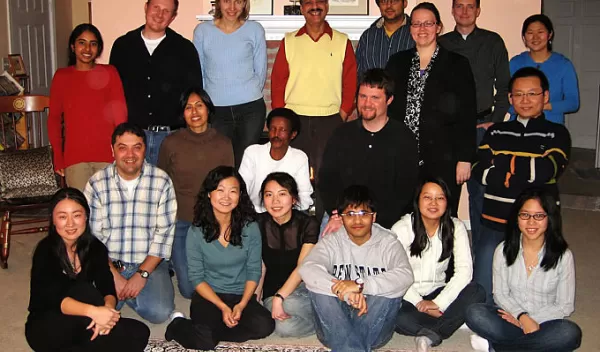
Nanoparticles Taught to Swim
Ayusman Sen, head of the Department of Chemistry at Penn State University, makes tiny, metallic objects do something extraordinary--he makes them swim.
"People make wonderful nanostructures, but they don't move around," said Sen. "Practically, if you want to move a nano-object from one point to another, you need a nano-motor and you have to power it. But these objects are so small, you can't hook them up with a piece of wire. Neither can they carry around their own fuel, so they have to use what's around them. In nature, it's done with catalytic reactions using substances from the surrounding environment."
Sen's work is driven by catalysis, the chemical phenomenon whereby a substance accelerates a chemical reaction but emerges unchanged at the end of the process. He and his team of students and colleagues focus their efforts on redox (reduction-oxidation) chemical reactions, where electrons and protons are broken away from their parent atoms and pumped back and forth between substances, liberating energy.
Motors much thinner than hair
In the context of nanomotors, that energy manifests itself as an electrical gradient in the fluid surrounding the tiny objects. For many of the team's experiments, the motors are platinum/gold nanorods only two millionths of a meter long, a length less than one hundredth the thickness of a human hair.
In most cases, the fluid starts out as a dilute solution of hydrogen peroxide that the researchers oxidize using a platinum catalyst tip on the nanorod.
The result is release of oxygen, along with electrons and protons, that flows from bow-to-stern of the tiny "ship," with electrons flowing inside the rod and an equal number of protons flowing in the fluid alongside.
At the stern, the electrons and protons catalytically reduce hydrogen peroxide to water. The protons flowing from stem to stern function like paddles, propelling the nanorod toward its platinum forward end, or if the nanorod is stationary, pumping water around it toward the aft end.
Purposeful ambulation possible
While getting metal particles to move under their own power is one thing, getting them to ambulate purposefully toward a specific location is another. In response, the Penn State team has developed three methods of steering their motors: magnetism, chemistry and light.
The magnetic system uses platinum- and gold-layered rods that contain magnetic nickel segments. These rods respond to an external magnetic field by swimming parallel to it.
The chemical system uses chemotaxis, traditionally defined as the movement of living organisms toward or away from a chemical attractant or toxin. In the first example of chemotaxis in a non-living system, Sen's platinum/gold nanorods propel themselves along a gradient of hydrogen peroxide diffused in water toward a higher concentration of hydrogen peroxide.
Phototaxis uses light to initiate catalytic activity. In a demonstration, silver chloride particles suspended in distilled water do not move until ultraviolet light is shone on them, whereupon they migrate en masse toward the light.
Moving particles that do something
As a practical matter, getting metal particles to move toward specific targets is not very valuable unless they do something like deliver a drug, assemble a structure, sense a material, or pump a liquid, once they get there. In order to prove the feasibility of such activities, Sen's group has developed electrostatic and chemical linkers to attach cargo to their nanomotors.
Summarizing his group's progress thus far, Sen reports, "We know how to load up cargo. We know how to move it. Once we learn how to unload cargo, we will have the equivalent of nano dump trucks that can deliver cargo to a designated site or lay down patterns to create superstructures."
Although at this juncture the group knows how to make the motors, attach cargo to them and transport them to designated points, off-loading remains a problem. In response, the group is beginning work on a photosensitive linker molecule that will break and drop the cargo when exposed to light.
-- Tom Imerito, Penn State University thomas@science-communications.com
This Behind the Scenes article was provided to LiveScience in partnership with the National Science Foundation.


